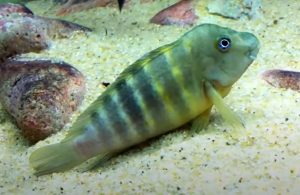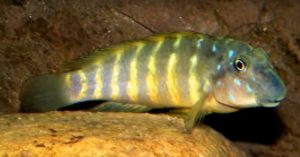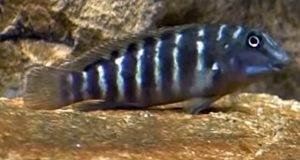The Horse Nose Cichlid (Eretmodus cyanostictus) also known to tropical fish keeping enthusiasts as the Striped Gopby Cichlid and Tanganyikan Clown Cichlid is endemic to Lake Tanganyika where it is found in the “surge zone” along the shallow surface layers of the rocky shorelines of Zambia and Tanzania where they scrape algae from the rocks with their specialized teeth.
Along with species from Eretmodus, Spathodus, and Tanganicodus; the Horse Nose Cichlid (Eretmodus cyanostictus) belongs to a group of cichlids commonly referred to as gobies or goby cichlids.
Because Horse Nose Cichlids inhabit very shallow rocky areas with strong currents and breaking waves, they have adapted to these conditions by developing long dorsal fins, a compressed body shape, and a non functional swim bladder that allows them to better cope with navigating the strong currents.
Horse Nose Cichlids have underslung mouths that allows them to remain flat against the rocks as they scrape off algae, and an extremely spiny dorsal fin that affords them some protection from birds and other predators that prey in the shallows.
Horse Nose Cichlids are sand colored with nine dark vertical bars along their sides. Several color forms of Eretmodus cyanostictus exist that are dependent on where the specimens were collected. Individuals collected from Kigoma have more red and orange in their fins than the those collected from the northern part of the lake.
Males and females are identically colored which makes them relatively impossible to sex, however, adult males are generally larger than females and also have slightly longer pelvic fins.
The fry can be reliably sexed up to a couple of days after release with males being a darker brown than females, but the color difference lasts only a few days.
Because Horse Nose Cichlids (Eretmodus cyanostictus) are adapted to living in the highly agitated water along the surge zones in Lake Tanganyika, more carbon dioxide is released into the highly oxygenated water which raises the pH. These conditions are also required to keep them healthy in an aquarium environment.
Eretmodus cyanostictus are best housed in a brightly lit Lake Tanganyika biotope aquarium setup of at least 55 gallon capacity, with a sandy or extremely fine gravel substrate and plenty of rockwork spaced along the bottom in piles for them to “hop” around. The rock piles should fill most of the aquarium and be arranged to form caves and crevices all the way to the top of the tank. Strong lighting is necessary to encourage algae growth and a sandy substrate is essential as an aid to digestion for this species.
Because Horse Nose Cichlids are a territorial species, they should not be kept with boisterous fish like Mbuna. In a community Tanganyikan aquarium, good tankmates include species that inhabit different areas of the aquarium like Cyprichromis, Paracyprichromis, Tropheus, Petrochromis, Simochromis and shell dwellers.
Horse Nose Cichlids can also be kept singly or as a pair. Once a pair has developed, they will remain together for life. Unless they are housed in a large aquarium, they are somewhat aggressive towards conspecifics.
Because Striped Goby Cichlids need highly oxygenated water to thrive, a good canister or trickle filter, at least a couple of power heads, and a few air stones are required to provide the necessary amount of oxygen. Regular 20% to 30% water changes are also highly recommended.
Eretmodus cyanostictus are bi parental mouthbrooders that are difficult to breed. They have a uniquely interesting spawning behavior and have been bred in an aquarium environment.
The best way to breed Eretmodus cyanostictus Gobies is to purchase a group of juveniles and allow them to pair off naturally in a large aquarium. Because Horse Nose Cichlids mate for life, purchasing an adult male and female does NOT guarantee a pair and will often result in the female being harassed to death.
Once a pair forms, remove the other fish from the tank and place the pair in an aquarium of at least 30 gallon capacity with some flat rocks for them to use as spawning sites. Place the rocks at varying levels in the tank, set the pH between 8.2 and 9.0, keep the temperature between 77 and 80° F, and provide strong oxygenation.
When ready to breed, the female will select a spawning site on one of the rocks and thoroughly clean it. The pair will then circle the site rubbing their mouths against each other’s stomachs until the female deposits 1 to 2 eggs that she immediately scoops up into her mouth.
The male has egg shaped spots on his anal fin which attracts the female to them. As the female turns around to scoop up the eggs, the male shakes his body to release sperm that fertilizes the eggs at the precise moment the female scoops them up and tries to add them to the brood in her mouth. This process is repeated until anywhere from 10 to 30 eggs are laid and fertilized.
The female may carry the eggs in her mouth for over 2 weeks and will not eat during this period. When the eggs hatch, the female transfers the fry into the mouth of the male. The transfer will usually occur at the spawning site where 1 or 2 fry will be gently blown out of the distended mouth of the female and picked up by the male, one at a time. At this stage the fry still have their yolk sacs. The male will incubate the fry for 7 to 14 days before releasing them over a period of several hours into different areas of the tank. During the incubation period, the male will also cease eating.
Horse Nose Cichlid parents will not eat the eggs or the fry, so unless you intend to breed the pair again, there is no need to remove the offspring into a raising tank. Once the male releases the fry into the tank, they are ignored by the parents and left to subsist on their own.
After the egg sacs are absorbed, the fry will eagerly accept powdered or finely crushed spirulina flakes or baby brine shrimp from the first day. Like many Tanganyikan species, growth is slow.
In their natural habitat, Horse Nose Cichlids are aufwuchs eaters that graze on algae that they scrape from the rocks in the shallows of Lake Tanganyika. In an aquarium environment, the food of choice for Eretmodus cyanostictus is a good Spirulina flake, vegetable matter such as blanched spinach, and supplements of live and frozen Mysis or Cyclops. Avoid feeding adults high protein foods such as meat, shellfish, worms, or brine shrimp at all costs.
The Horse Nose Cichlid (Eretmodus cyanostictus) is an overlooked species that due to their specific requirements and sensitivity is not recommended for anyone but advanced tropical fish keeping enthusiasts. They are occasionally available from specialty tropical fish shops and online from a variety of sources at relatively reasonable prices.
Minimum Tank Size: 55 gallons
Care Level: Difficult
Temperament: Aggressive
Aquarium Hardiness: Delicate
Water Conditions: 75-82°F, pH 8.0-9.0, H 10-25°
Max. Size: 3.2″
Color Form: Brown, Blue
Diet: Carnivore
Compatibility: Tanganyikan Community or single species tanks
Origin: Lake Tanganyika, Africa
Family: Cichlidae
Lifespan: 8-10 years
Aquarist Experience Level: Advanced




